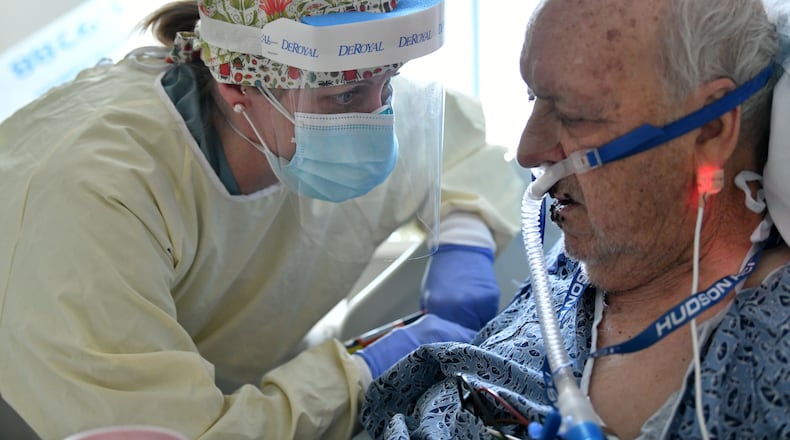Dr. Clifton Hastings took to social media two days before Christmas with an urgent plea.
In a dramatic video, the veteran surgeon warned that Northeast Georgia Health System, where he served as chief of staff, was reaching a breaking point. The number of COVID-19 patients at NGHS hospitals already had doubled in less than a month. The staff was stretched, space was running short. Standing in front of a mobile medical unit, surrounded by weary colleagues, Hastings pleaded for people to protect themselves, their families and the entire community from COVID-19 over the holidays.
The hospitals, he warned, may not be able to care for everyone if the surge intensified.
Two weeks after Christmas, scenes Hastings feared began to play out at Northeast Georgia’s medical centers —and at almost every hospital across the state.
COVID-19 patients, 345 in all, filled about half of all the beds at NGHS hospitals on Jan. 8. Dozens of other patients were in the Emergency Department at the system’s Gainesville hospital waiting for a room. Some couldn’t even get in the ER. Even after one expansion after another throughout the pandemic — with tents and mobile units set up, a gym converted into a hospital ward and regular rooms into ICU space — it was too much.
“I walked out and there were eight ambulances in the ambulance bay, and there was a trauma surgeon crawling out of the back of the ambulance because he’d gone in there to evaluate the patient to triage, there was an E.D. doc — I mean the people in the ER are going out to the ambulances,” he said. “We had 15 people in the gym, we had 20 people in trailers, we had patients in the hallways.”
In the few days that followed, the staff watched with relief as the patient load dipped a bit. But then, the COVID-19 deaths started setting records, not just where Hastings works but across Georgia.
To deal with the casualties, NGHS resorted this week to bringing in a mobile morgue in Gainesville. That would have been unthinkable just a year ago, but was just one of many unimaginable steps hospitals are taking during the crisis.
“It just almost hurts your soul to see so much death and sadness,” Hastings said.
This week marks the anniversary of the first confirmed COVID-19 case in the United States. One year in, more than 400,000 Americans have died of the virus, about 12,000 of them from Georgia. While the rollout of vaccines offers some hope, the dark reality is that trendlines of the pandemic are steepest now. Hospitalizations in Georgia reached their highest points this month. COVID-19 deaths are setting records.
Doctors and nurses at hospitals across Georgia say what they are going through is best described by one word. War.
“We still have folks who question the seriousness of COVID-19, and all I can say to them is I wish I could give you a tour of our facility, the inside tour,” said Dr. Deepak Aggarwal, who recently took over from Hastings as NGHS chief of medical staff. “It truly looks like a war zone.”
Credit: HYOSUB SHIN / AJC
Credit: HYOSUB SHIN / AJC
Brutal scenes
Across the state, hospitals don’t look or sound like they did before the pandemic. The state sent mobile medical units to hospitals in Rome, Albany and Macon as they started running out of beds. Northeast Georgia Medical Center got one, too, at its Gainesville headquarters.
Hospitals have also converted beds to ICUs.
Glass shields are up at nurses’ stations, and carts of PPE and patient beds have taken over some hallways.
Then there’s the noise. Hospitals had to quickly create “negative pressure rooms” by adding fans and large tubes to pull out air that could be carrying the virus. Hallways that were once quiet sound like a “factory” with all the fans going, Hastings said.
Doctors often have to yell just to be heard.
“It just almost hurts your soul to see so much death and sadness."
The noise and disarray contribute to the war-zone atmosphere. Plus, like wounded soldiers a continent away from home, hospitalized patients with COVID-19 usually don’t have their families at their bedsides. The doctors and nurses are often the ones holding their hands at the end.
Crystal Corbin, a registered nurse at Habersham Medical Center in Demorest, said the ‘code blues,” summoning teams for medical emergencies, seem to come one after another, like the deaths.
“Every nurse I know is tired,” she said. “Every nurse I know feels defeated. We are so tired of feeling this way. But what about our patients, their families, and their loved ones? How do they feel when they are told ‘No, you cannot come in and hug your mom, dad, brother, sister…for the last time.’ And then their loved one…our patient dies. I keep telling myself, ‘Stop crying. Suck it up. There is no time for tears. It will get better.’ But will it?”
Hospitals can double their ICU space and set up tents. But they can’t quickly double the number of critical care doctors and nurses. The state of Georgia has tried to help, sending hundreds of doctors, nurses and other staff to hospitals. The week of January 10, more than 1,300 of these workers fanned out to assist with the surge. While that’s helped to save the day, it doesn’t mean any other worker gets to go home. Every hand is needed, and it’s been that way for nearly a year now.
Credit: HYOSUB SHIN / AJC
Credit: HYOSUB SHIN / AJC
Dr. Erine Raybon-Rojas, an ICU physician at Northeast Georgia, remembers the day she had four patients code in two hours. She had just done three crash intubations before moving on to another patient, a young woman, who was crashing, too. This was early in the pandemic. Doctors and nurses were wearing make-shift plastic gowns and face shields along with their masks.
Dr. Hastings was watching this play out through glass doors. Two nurses and two doctors, sweating under the plastic gear and N95 masks, worked nonstop for several hours on the patient. She didn’t make it.
“They come out and they’re in tears and it’s extremely frustrating,” Hastings said, remembering the brutal scene. The team was covered in sweat, exhausted and discouraged. “And it’s 11:30 in the morning, you had the rest of the day to go and you pulled it together and did it, but that was rough.”
PPE is a little more plentiful these days, but so are the patients and the demands on those like Raybon-Rojas. Nobody imagined that this would go on so long with such intensity. She has a routine now that she never breaks when starting her shift.
“I always pray,” she said. “I pray for, you know, the nation. I pray for my colleagues. I pray for the doctors, I pray for the nurses. I pray for the families and the patients.” She makes sure she puts on her first round of PPE before she walks in the door, and she braces for what’s to come.
“When I come in, I’m usually attending to some emergency the second I put down my bag, and then next thing you know, it’s one o’clock and I’ve been in an N95 mask for six hours straight.”
At the system’s Braselton location, where she works many shifts, Raybon-Rojas said during a recent week there had been 13 deaths in one critical care unit and more were likely before the week’s end. “That’s just unprecedented,” she said.
Credit: HYOSUB SHIN / AJC
Credit: HYOSUB SHIN / AJC
Other battle-weary health care workers wonder how much more they can take.
Shaun Hall, a clinical supervisor of ICU units at Phoebe North, Phoebe Putney Health System’s COVID-19 hospital in Albany, said a nurse for critically ill patients that might have seen one or two deaths a week now may see six or eight. “It’s not easy,” Hall said.
“I had to pull a nurse in just this morning. She was one-to-one with this patient for six or seven straight days. You cannot avoid a connection. You will connect with that patient, and with the family. And we lost her overnight; it was unexpected.”
“I said, ‘Jo, before you get in there I need you to know we lost Bed 1 last night.’
He saw the nurse’s face change. She didn’t cry, but he imagines she did after leaving his office. Then she went to her next assignment. “She’s in a different area,” Hall said, “but she’s got two of the sickest patients we have.”
Preparing for death
Before the pandemic — some in healthcare now call it “peacetime” — the work in hospitals was predictable. Doctors knew how to handle patients. They had the supplies and space they needed. Now, every shift can feel like stepping into a battle.
“Walking up to our COVID ICU, walking in the door, I have a physical response,” Raybon-Rojas said. “Palpitations, sweat and a feeling of shortness of breath because every time I walked through those doors, it reminds me of when this started. And then I start to think, when is this going to end?”
The other burden, she said, is the risk of death every caregiver faces. “It’s the fear of our own mortality that we have to look at every day,” she said. “The conversations within the critical care team that we actually have with each other, we are telling each other what we would want and what we wouldn’t want, if we should get sick. We’re actually talking about, OK, we’re going to manage the vent like this. I’ve already talked with my wife or my husband about this. Take care of my dog like this. These are the medications I’m on. Please make sure I get these. These aren’t normal conversations.”
Raybon-Rojas said every single time she gets home from work — for nearly 11 months now — she changes clothes in the garage, where her husband usually hands her a robe. She heads immediately to the shower. She hugged her mother once in all of 2020. She hasn’t been to a restaurant.
“It's the fear of our own mortality that we have to look at every day."
The NGHS chief of staff, Dr. Aggarwal, changes in the garage, too. His kids aren’t allowed to sit in his car or hug him right away — even when they come racing to him when he walks in the door. He updated his living will, and he and his wife explained to each other the household tasks each handles, just in case. He told his wife, “I want to make sure you’re able to carry on, if I’m not there.”
The possibility isn’t so far fetched. Hundreds of the system’s employees have tested positive. Some have died. A woman who worked as-needed shifts at Northeast Georgia was hospitalized with COVID-19 at the same time her husband was. She made it through. He didn’t, leaving her to raise their two small children alone. He was 36. Just last week, the personal assistant to the system’s CEO Carol Burrell lost her husband to COVID-19. He was healthy before he got the virus, and the couple had planned a trip to the beach after Christmas. The trip never happened.
Aggarwal said he came into the ICU one day to care for a COVID-19 patient. He recognized her. “‘Oh my God’,” he remembers saying, “‘This is one of our staff members.’ And she eventually passed away. It was a tough, tough thing to face because just a month or two months ago, she was walking around.”
Credit: HYOSUB SHIN / AJC
Credit: HYOSUB SHIN / AJC
Pleading with God
In the midst of the dark days of the recent surge, a bit of hope began to surface with the arrival of vaccines. “This last set of days that I worked have been the hardest in the past year, but right before I went into this stretch of days, my husband, both of my parents, and one of my sisters in California, all got vaccinated on the same day,” Raybon-Rojas said. “That was the best sleep that I had had in months, just knowing that they were vaccinated.”
But that hasn’t stopped this stage of the war from being the worst so far. COVID-19 deaths this week continue to shatter records. Hospitalizations started to drop slightly but remain dangerously high. All of Atlanta’s larger hospitals are at — or over — capacity. Somehow, hospitals continue to stretch to take in more patients than they ever imagined.
That doesn’t mean they could take them all.
Cheryl Lee, director of nursing at Clinch Memorial Hospital, said her toughest day of the pandemic came during the post-holiday surge flooding hospitals. The Homerville hospital had two patients who needed to transfer to a larger hospital for care. “Every time we called, they would tell us they had no ICU beds,” Lee said.
Doctors had to go in and talk to one of the patients, who was just 50 with no comorbidities, about possible end-of-life measures to find out what she wanted. “She was just crying out to God, “Don’t take me now. I want to see my first grandchild. Please don’t take me now. Please don’t take me now,” Lee said. The hospital finally got her transferred to a Florida facility, where she was just put on a ventilator.
“I was real torn up and I wanted to cry myself because this lady was my age and she had three children and I have three children,” Lee said. “You don’t expect somebody 50 years old to be in this kind of shape. It’s awful.”
Even with all of the illnesses and deaths, doctors and nurses hear people say COVID-19 isn’t real or isn’t causing serious health issues. “I’ve had people I was about to intubate who still told me COVID was a hoax as I’m about to put the breathing tube in,” Raybon-Rojas said.
Now at the one-year point, workers wonder what it will take for everyone to believe COVID-19′s toll. They also wonder how much longer they can handle the frontlines. Maybe the state has reached its ultimate peak. But with a new, more contagious variant of the disease out there, and a vaccine effort that will take many months to complete, worse battles could come. Fighting those comes with a price.
“COVID changes you,” said Corbin, the nurse from Demorest. “Today, I watched my coworker, my friend, and the one I aspire to be, cry about halfway through our shift because she could not help another one of her patients live. Mama J, as most know her, is the strongest nurse I know. She is the glue that holds our unit together. She has more than 20 years of nursing experience. But today, she broke down and was inconsolable. In that moment, I questioned God. ‘If Mama J cannot handle yet another death, how in the world can I? How can I muster up the strength to say goodbye to another one of my patients again…and again…and again?”
The Latest
Featured








